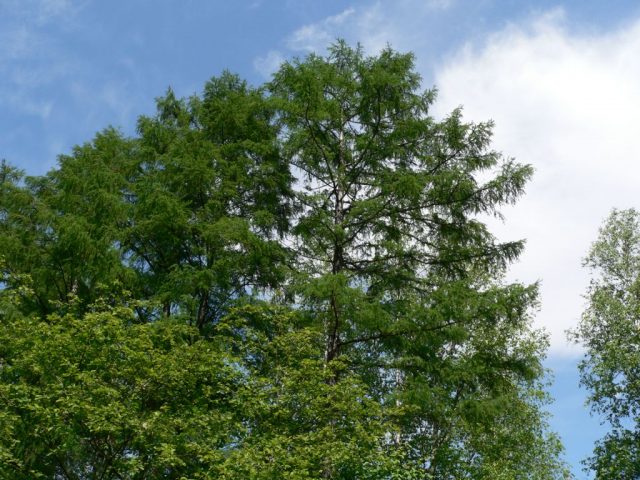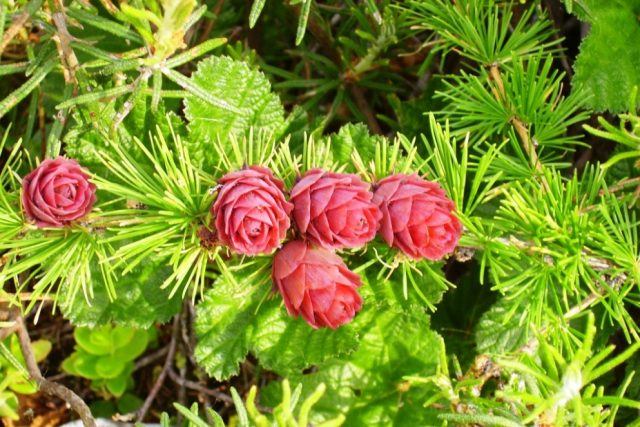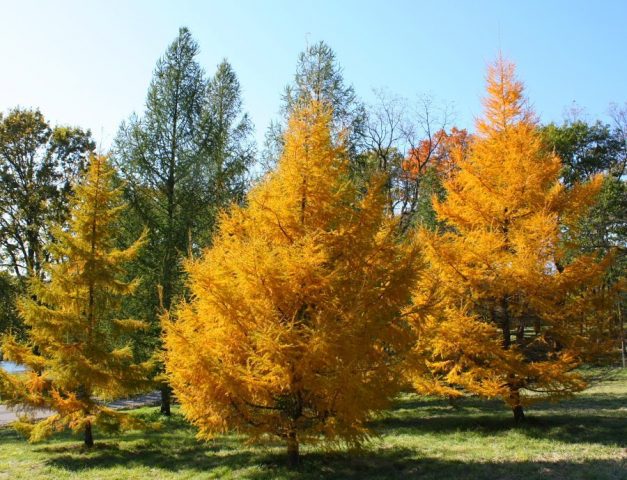Content
Daurskaya or Gmelin larch is an interesting representative of conifers of the Pine family. The natural area covers the Far East, Eastern Siberia and northeastern China, including the valleys of the Amur, Zeya, Anadyr rivers, and the coast of the Sea of Okhotsk. In mountainous areas, the Daurian species grows at high altitudes, taking a creeping or dwarf form, it is also found in lowlands, on boggy maria and peat bogs, and easily masters rocky mountain slopes.
Description of Daurian larch
Gmelin or Daurian larch (Larix gmelinii) is a powerful, extremely hardy deciduous tree, reaching a height of 35-40 m in adult form. The average life span is 350-400 years.
Young shoots of the Daurian variety are distinguished by light yellow, straw or pinkish bark with little pronounced waviness and pubescence. With age, the bark becomes thick, deeply fractured, its color changes to reddish or brown-gray.
The needles are of a rich bright green shade, thin, narrow and soft to the touch, smooth on top, and have two longitudinal grooves below. The length of the needles is 1.5-3 cm, on shortened shoots it is formed in bunches of 25-40 pcs. In autumn, the color of the crown changes to honey-yellow.
The needles of Daurian larch (Gmelin) bloom in late April or early May, earlier than other species of larch. During this period, the ground at the roots has not yet melted to the end. Along with the appearance of new needles, flowering also occurs. Male cones are oval in shape, located mostly from the bottom of the branch on shortened naked shoots. The pollen of the Daurian larch does not have air sacs and does not scatter over long distances. Female cones are egg-shaped, do not exceed 1.5-3.5 cm in length. The scales are arranged in 4-6 rows, the average number is 25-40 pcs. The color of young female inflorescences is lilac-violet; in adulthood, the color changes to red, pinkish or green. Pollination occurs through the wind, after a month the cones are fertilized. The seeds ripen in late summer or early autumn, in clear, dry weather, the cones open, allowing the seeds to fall out.
Daurian larch in landscape design
Daurian larch (Gmelin) is a valuable species for decorating a personal plot or garden. Most often it is planted as a tapeworm - a single plant that draws attention to the entire composition. Also, Daurian larch is used to create groves.
Daurian larch combined with other deciduous trees is a classic layout of the northern garden. It also looks good against the background of evergreen conifers - pine, fir or spruce. The species tolerates pruning well, but is not suitable for curly hairstyles. Young shoots of Daurian larch (Gmelin) are elastic and flexible, they can be easily intertwined, creating living arches, gazebos or pergolas.
Planting and caring for Daurian larch
Daurian larch is a northern tree species that can withstand temperatures down to -60 ° C. It is extremely light-requiring, but not at all demanding on the composition of the soil.It can grow both on rocky slopes and on sandstone, limestone, wetlands and peatlands, in places with a shallow layer of permafrost. The best soil for Gmelin larch is considered to be moist loam with the addition of lime.
Seedling and planting plot preparation
Since the Daurskaya larch (Gmelin) perfectly tolerates transplantation, both adult specimens (up to 20 years old) and annual seedlings are suitable for a summer cottage. For landscaping, 6-year-old specimens are used in soft containers, older trees are transplanted in hard containers or with a frozen earthen clod.
The transplant is carried out in early spring before bud break or in autumn after the needles have completely fallen off. Thanks to its powerful root system, which goes deep down, Daurian larch is not afraid of strong winds. For her, they choose a sunny open place and dig a hole 50 * 50 cm, depth - 70-80 cm.The distance between neighboring trees should be at least 2-4 m. A soil mixture is prepared by adding peat and sand to the leafy ground at a rate of 3: 2: one. The pit is left for 2 weeks so that the soil settles.
The seedlings are inspected for mechanical damage and pests. It is important that there are no scratches and cuts on young roots, since the mycelium of a symbiotic fungus is located on them, which acts as root hairs.
Landing rules
The planting algorithm of Daurskaya larch (Gmelin) does not differ from the planting of other representatives of this genus:
- In a place prepared in advance, a recess is dug, commensurate with the earthen coma of the seedling.
- On heavy clay soils, a drainage layer must be laid on the bottom - at least 20 cm (broken brick, crushed stone, gravel).
- When planting, humus or compost can be added to the soil; the use of manure is highly undesirable.
- The pit is spilled 2-3 times with water and allowed to soak.
- A young seedling is placed in the center, if necessary, straighten the roots and cover it with earth, trying not to deepen (the neck should be at ground level).
- A young tree is watered with cold, settled water, spending at least two buckets per copy.
- The near-stem circle is mulched with sawdust, peat, pine bark or needles.
- At first, young seedlings of the Daurian larch need shading from direct sunlight.
Watering and feeding
Gmelin larch loves well-moistened soil. The top layer of the soil should not dry out. Adult larch trees are quite drought-resistant, in contrast to young seedlings, which need regular watering 2 times a week.
In order for the ephedra to take root and grow faster, it must be regularly fed with complex mineral fertilizers with a high content of potassium and phosphorus. For 1 m², 50-100 g of top dressing is applied.
Mulching and loosening
Loosening and removal weeds especially important for young seedlings of Gmelin larch. So that the top layer of the soil does not dry out quickly, the ground near the trunk is covered with mulch from peat, sawdust, bark, and needles. The layer must be at least 5 cm.
Pruning
Daurian or Gmelin larch grows somewhat slower than other species and rarely needs pruning. It is possible to form a tree only at a young age; adult larches are subjected only to sanitary pruning, in which dried and damaged branches are removed. The procedure is carried out when the period of active growth of young shoots ends, but lignification has not yet occurred. Pruning Gmelin larch is also necessary to control the height of the tree.
Preparing for winter
In addition to resistance to drought, waterlogging and soil salinity, Daurskaya (Gmelin) larch perfectly tolerates the most severe frosts.Mature trees do not need shelter; young trees can be wrapped in two layers of burlap for the winter.
Reproduction of Daurian larch (Gmelin)
Gmelin larch reproduces by seeds. After the needles fall on the tree, light brown cones are selected, they are dried at room temperature until the scales open. The fallen seeds are folded into a paper bag and placed in the refrigerator until spring.
Seeds of Larix gmelinii germinate well without stratification, however, this procedure will significantly increase the germination rate. A month before sowing, the seeds are soaked for a day in water at room temperature. Then it is mixed with moistened coarse sand in a ratio of 1: 3 and placed in a refrigerator.
Gmelin larch seeds are sown in late April or early May. They are sealed to a depth of 1.5 cm, sprinkled with a sand-peat mixture on top. Upon completion of sowing, the soil is slightly compacted and covered with spruce branches or straw. When the seedlings of the Daurian larch appear from the ground, the mulch is removed. Young larch trees do not tolerate the slightest shade, therefore regular weeding of plantings is the key to active growth and proper development of seedlings.
Gmelin larch can be propagated by layering and grafting, however, this method is very difficult for an ordinary gardener and is used in industrial nurseries or greenhouses. For planting in a garden plot, it is easier to buy a ready-made seedling.
Diseases and pests
Gmelin larch can suffer from a number of pests:
- larch miner moth;
- hermes;
- coniferous worms;
- sawflies;
- larch sheaths;
- bark beetles;
- bast beetles;
- barbel.
To combat, systemic insecticides are used, for the prevention of beetles in early spring, the crown of the larch and the soil around the trunk are treated with karbofos.
Gmelin larch is susceptible to some fungal diseases, such as:
- shute (meriosis);
- rust;
- alternaria;
- tracheomycotic wilting.
For treatment, fungicides are used, severely damaged specimens should be uprooted and burned.
Conclusion
Daurskaya larch (Gmelin) has found wide application in landscape design due to its unpretentiousness, exceptional frost resistance and high decorative effect. It will become an adornment and the main accent of any personal plot, will delight the eye with its fluffy, juicy green crown.











